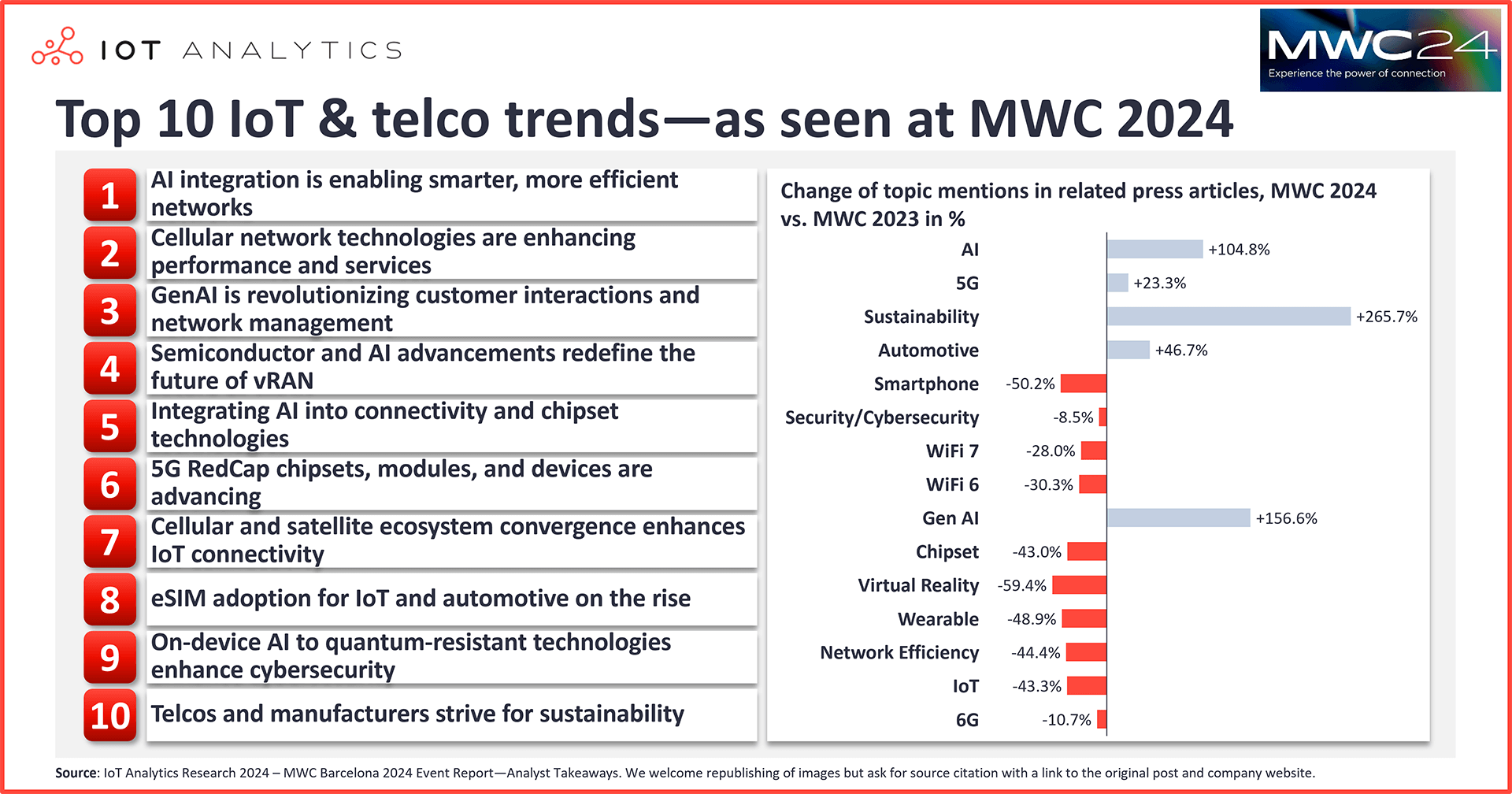
In short
- The current state of telecommunications was on full display at MWC Barcelona 2024.
- IoT Analytics’ three-analyst team produced a 123-page event report, covering 130+ companies, and presents its top 10 trends on the state of IoT & telecommunications here.
Why it matters
- MWC is one of the world’s most important telecommunications trade shows. The showcased technologies are widely applicable to IoT connectivity.
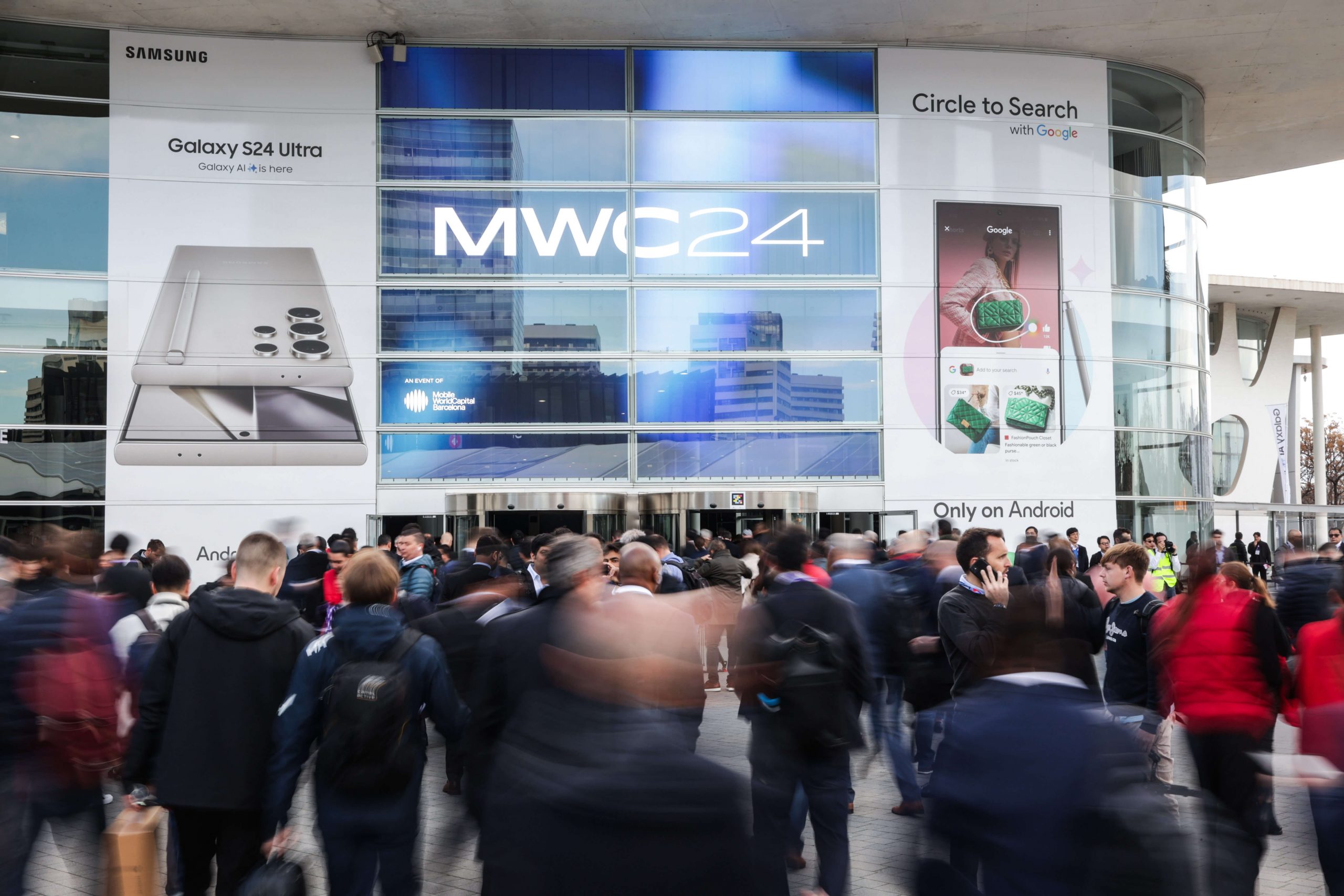
Mobile World Congress 2024
The Mobile World Congress (MWC) Barcelona 2024, which took place from February 26 to February 29, is the telecommunication (telecom) industry’s main event showcasing the latest technologies and solutions, such as 5G, edge computing, and AI.
The MWC saw a significant increase in attendance in 2024, with a rise of 14% compared to the previous year. The event drew in 101,000 attendees. It hosted 2,700 exhibitors—a testament to the industry’s resilience and the undiminished allure of cutting-edge mobile technologies.
However, attendance was still 7% lower than at MWC Barcelona 2019, before the COVID-19 pandemic. On the other hand, the number of exhibitors increased by 12% from the pre-COVID era, reaching a new five-year record high.
“MWC Barcelona embodies the energy and vibrancy of the mobile ecosystem. We are honored to host this special event, which, once again, has delivered an exceptional four days of debate, thought leadership, inspiration, and deal-making.”
– John Hoffman, CEO, GSMA Ltd.
IoT Analytics had a team of 3 analysts on the ground during the event’s four days. The team visited approximately 60+ booths and conducted more than 50 in-person interviews to comprehensively understand the most recent developments. Nearly every meeting started with, “What’s new in MWC, apart from AI?”
That said, AI was a common theme among the numerous new products and projects showcased at MWC 2024, from network operations management down to the chipsets themselves. However, AI was not a part of every notable advancement.
Our research clients can refer to the full 123-page MWC Barcelona 2024 Event Report to read more about the myriad of new technologies, trends, announcements, and insightful quotes from key telecom industry players. This article only highlights some of the major trends.
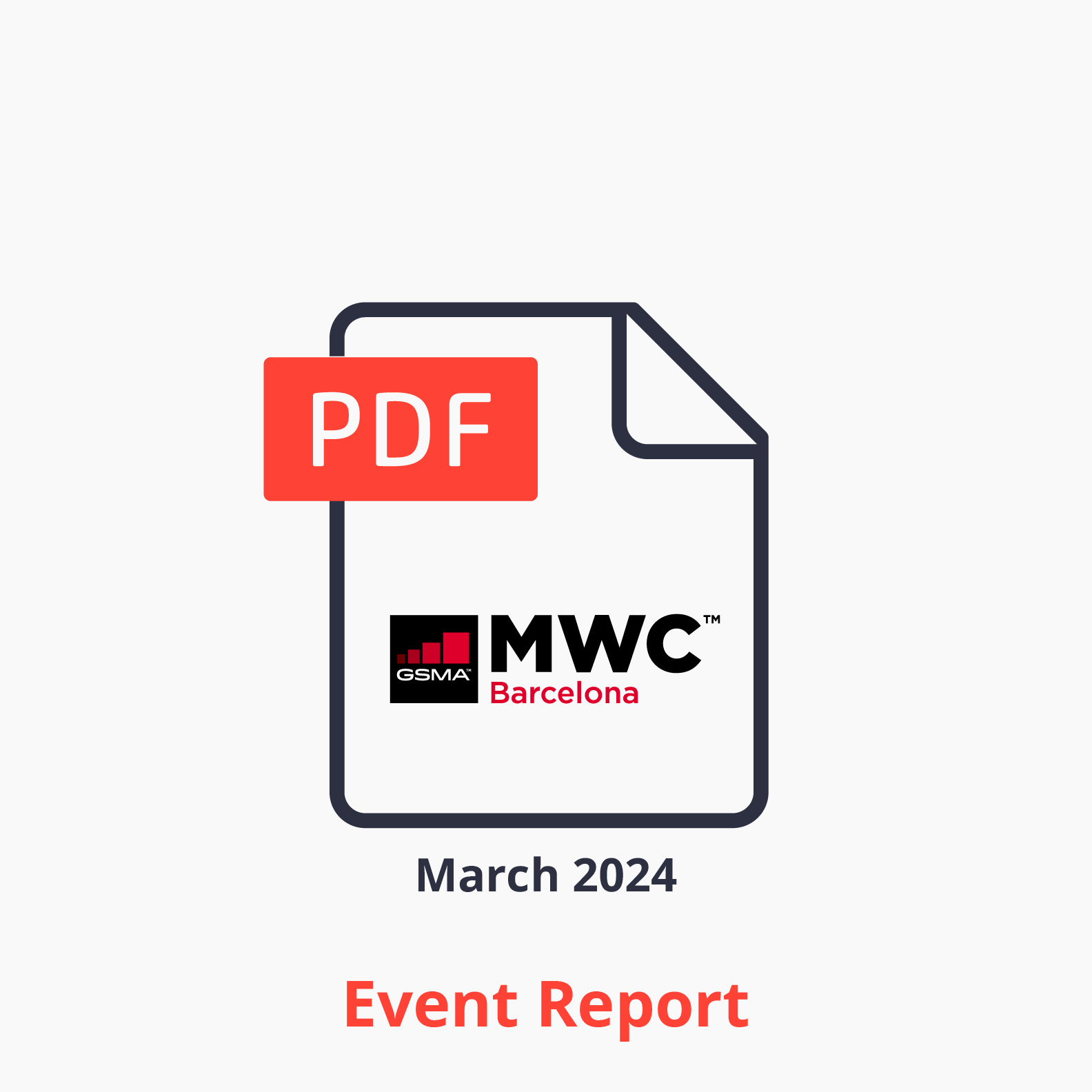
This article is based on insights from:
MWC Barcelona 2024 Event Report—Analyst Takeaways
Download a sample to learn about the in-depth data that are part of the report.
Already a subscriber? Browse your reports here →
10 IoT and telco trends observed at MWC 2024

The full report shares 41 telecom industry trends the IoT Analytics team observed, including AI integration, telecom and satellite convergence, security, and sustainability. Here, we will highlight 10 trends that showcase the future of telco IoT connectivity, with a summary of each.
1. AI integration is enabling smarter, more efficient networks
The telecom industry spotlighted the integration of AI into telecom networks, particularly Radio Access Networks (RAN), emphasizing the shift towards more intelligent and automated network operations. Propelling this trend is the need for cost reductions, enhanced user experiences, and the mitigation of skill shortages.
AI’s role in telecom networks now includes smart monitoring, efficient analysis, and improved anomaly detection—offering solutions to the growing complexity of networks and cybersecurity threats. Companies are focusing on user-friendly AI tools that are accessible to developers with varying levels of expertise in AI/ML, thereby addressing the pressing need for innovation in network management and security.
Sweden-based multinational telecommunications company (telco) Ericsson introduced the Telecom AI concept, emphasizing zero-touch operations, trustworthy AI, and AI’s integration into networks. This initiative underscores the industry’s move towards automation, with AI enabling networks to adapt to user demands dynamically. This fosters a more responsive and adaptive telecom infrastructure.
Meanwhile, Japan-based mobile network operator Rakuten Mobile partnered with OpenAI, the US-based developer of ChatGPT, to develop AI tools for the telecom industry. This partnership aims to deploy AI solutions to open RAN’s architecture to enhance customer service and network optimization.
2. Cellular network technologies are enhancing performance and services
At MWC 2024, the integration of standalone 5G (SA 5G) with network slicing, the commercialization of 5G-Advanced (5G-A), and AI’s foundational role in the impending 6G networks highlight an evolution in telecoms. Collectively, these developments enhance network performance, efficiency, and the capacity to support a myriad of new applications and services.
Network slicing, a significant innovation driven by SA 5G deployments, allows customized network segments catering to diverse needs, optimizing resources, and bolstering security. It facilitates novel business models by offering personalized network experiences underpinned by technologies like Open RAN Intelligent Controllers (RICs) and machine learning.
Regarding SA 5G with network slicing, Finland-based telecom and IT company Nokia demonstrated multi-access edge slicing in partnership with e& UAE, a UAE state-owned telco, over a live mobile network. Multi-access network slicing allows e& UAE to offer new premium slicing services across 4G/5G, fixed wireless access, and fixed access that can support several use cases and applications simultaneously. Further, US-based semiconductor company Qualcomm showcased AI-driven 5G RAN network slicing capabilities within its Edgewise Suite.
Meanwhile, regarding 5G-A, China-based telecom equipment and services provider Huawei announced at MWC 2024 the world’s first 5.5G intelligent core network, which offers a tenfold speed increase over the initial 5G speeds.
Finally, regarding AI integration into future 6G networks, South Korea-based telecommunications operator SK Telecom shared a proof-of-concept video demonstration of a collaborative AI integration effort between it, Japan-based telco NTT, NTT’s telecom-provider subsidiary DOCOMO, and Nokia. The demonstration was for this team’s implementation of AI in the 6G air interface, which aims to enhance performance while minimizing energy consumption.
3. GenAI is revolutionizing customer interactions and network management
The IoT Analytics team noted 20 generative AI (GenAI) showcases at MWC Barcelona 2024, highlighting a significant shift toward leveraging GenAI to enhance customer interactions and improve network operations. Telcos showcased various GenAI-powered solutions across different stages of development, with most aiming to provide real-time, efficient customer service and network troubleshooting.
Of the 20 identified GenAI showcases, 10 were customer interaction and support use cases, making it the largest use case. Only 5 of the 20 showcases have been rolled out across the respective organizations or to customers—most others are either being piloted or their status is otherwise not known.
UK-based multinational telecom company Vodafone showcased its updated TOBi chatbot supported by Microsoft Azure’s OpenAI Service. TOBi has managed various customer interactions, including billing journeys, offers, and appointment booking, for Vodafone for years, but with GenAI integration, it can handle natural language well and personalize customer experiences. Meanwhile, Qualcomm presented its Edgewise Suite, a GenAI-powered RAN network management consultant system designed to simplify network and slice management tasks for RAN engineers. Its solution features impact assessment modeling, network topology, network performance tracking, gateway provisioning, and knowledgebases (including external data sources).
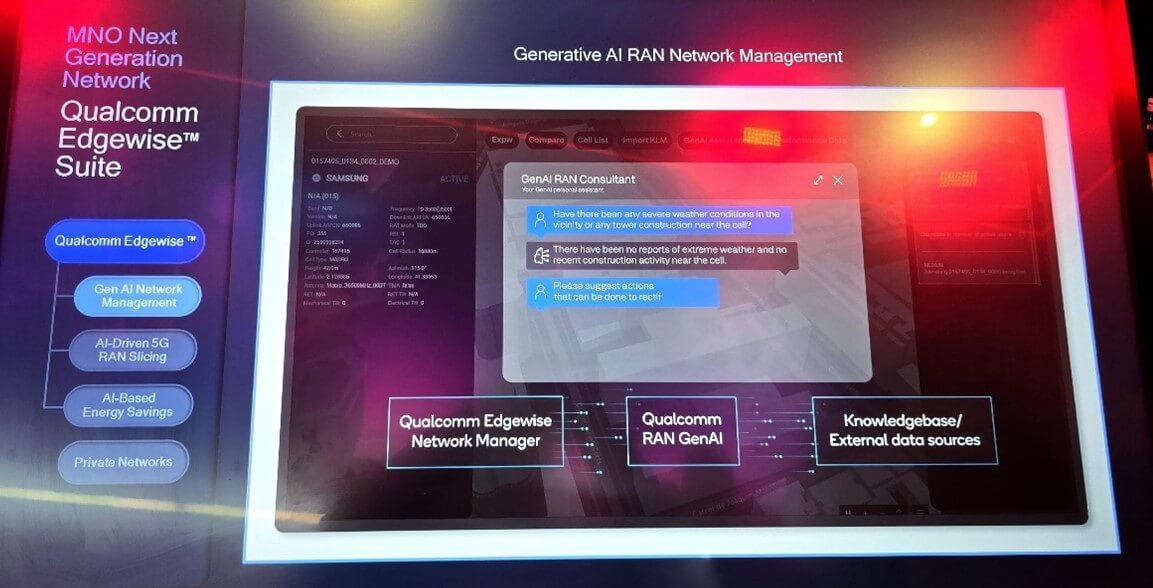
4. Semiconductor and AI advancements redefine the future of vRAN
The evolution of virtual RANs (vRANs) is at the forefront of mobile network development and is greatly influenced by semiconductor innovations and AI integration. Semiconductor companies are pivotal in this transformation, offering specialized processors and chipsets that boost vRAN performance, which can provide a cost-efficient, adaptable, and advanced architecture.
Meanwhile, AI’s inclusion within vRAN accelerator cards revolutionizes network efficiency, flexibility, and intelligence. AI algorithms run on specialized hardware such as CPUs, GPUs, and vRAN accelerator cards to optimize 5G networks.
Collaboration between leading telecoms is facilitating these advancements. At MWC 2024, Nokia and US-based semiconductor company NVIDIA unveiled a partnership integrating Nokia’s RAN software and layer 1 acceleration with NVIDIA’s CPUs for layer 2 processing and its GPUs for AI and vRAN acceleration. This collaboration marks a significant milestone towards AI-driven RAN solutions (AI-RAN).
US-based semiconductor company Intel announced the upcoming launch of its Xeon Granite Rapids-D processors, designed specifically for vRAN workloads. These processors will be equipped with high-performance, next-generation P cores and enhanced with Intel vRAN Boost acceleration.
5. AI integration into connectivity and chipset technologies
The previous trends highlight AI integration into telecom infrastructure, with advanced modules and chipsets to help accelerate AI. However, the technology industry is experiencing a transformative phase with AI integration into modules and chipsets themselves.
Telecom vendors are now embedding AI directly within connectivity modules and 5G chipsets, aiming to revolutionize how devices process data, manage network traffic, and optimize performance.
At MWC 2024, several companies showcased their latest module and chipset innovations with AI integration. For instance, Cina-based cellular module provider MeiG presented a comprehensive product line of AI modules—the SNM930 and SNM970—which boast AI computing power up to 48Tops and support high-end applications such as service robots.
Similarly, China-based cellular module providers SIMCom and Fibocom showcased their AI integrations. SIMCom introduced the SIM9650L Wi-Fi 6E module, featuring an 8-core processor and AI capabilities exceeding 14 Tops. This module is suitable for devices like intelligent point-of-sale systems and VR/AR devices. Meanwhile, Fibocom highlighted their SC208 module, powered by Qualcomm’s Snapdragon 460 platform and capable of efficiently handling complex tasks like 1080P video transmission and multi-camera inputs.
Note: IoT Analytics released its updated global cellular IoT module and chipset market tracker earlier in March 2024 and plans to release an article about it in early Q2 2024.
6. 5G RedCap chipsets, modules, and devices are advancing
Speaking of chipsets in general, several manufacturers unveiled new 3GPP Release 17-compliant 5G RedCap chipsets at MWC 2024. These chipsets emphasize enhanced power efficiency, lower development costs, and support for various applications.
Module manufacturers appear to be seizing the 5G RedCap opportunity by developing pre-tested modules that facilitate quicker and more reliable device development. These modules, often equipped with advanced power-saving features and high data throughput capabilities, are fostering the deployment of new devices and gateways across various industries.
For example, China-based IoT module manufacturer Lierda showcased its TE310 5G RedCap Industrial Gateway, equipped with a 5G RedCap NR90-HCN module, Gigabit Ethernet port, and Wi-Fi6 technology. Meanwhile, US-based private network solutions provider MosoLabs presented its Moso Connect 5G mobile adapter, which allows legacy machines with serial or ethernet connectivity to communicate over a private 5G network. Additionally, Ericsson demonstrated video surveillance capabilities using 5G AIoT cameras integrated with 5G RedCap modules.
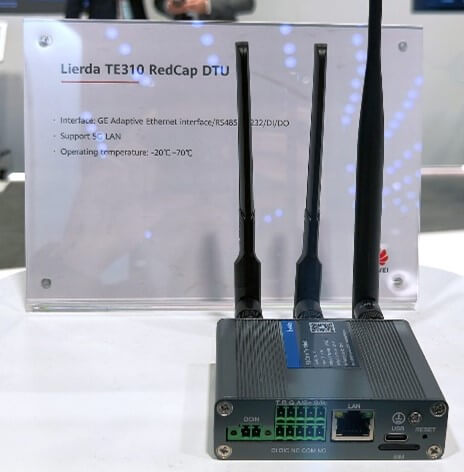
Devices like these underscore 5G RedCap’s versatility and potential to enhance connectivity and reliability for various applications.
7. Cellular and satellite ecosystem convergence enhances IoT connectivity
The integration of satellite connectivity into cellular networks is revolutionizing global IoT deployment. Underscoring this trend is the proliferation of 3GPP non-terrestrial network (NTN) capabilities in chipsets and modules and the telcos’ embrace of satellite connectivity for ubiquitous IoT coverage.
At MWC 2024, the IoT Analytics team noted several collaborations and certifications highlighting this convergence. Examples on the telco front are Deutsche Telekom, a German telecom provider, launching IoT tariffs with geostationary satellite providers, and US-based non-geostationary satellite infrastructure provider Omnispace collaborating with MTN, a South African multinational telecom provider, to enhance 5G connectivity through low-Earth orbit satellites.
On the satellite front, in July 2023, US-based NTN service provider Skylo Technologies partnered with Keysight Technologies, Inc., a US-based electronics testing and measurement equipment manufacturer, to expand cellular testing to NTNs via a certification program for NB-IoT devices over satellite. At MWC 2024, Skylo announced that Keysight extended the number of available test cases to 145 in the Keysight RF/RRM Carrier Acceptance Toolset, which enables certification of 3GPP 5G Rel-17 NTN chipsets, modules, and devices for Skylo’s network.
Such advancements aim to enhance performance, reliability, and coverage, especially in remote areas where traditional connectivity is limited.
8. eSIM adoption for IoT and automotive on the rise
The global landscape of eSIM technology is witnessing transformative shifts, notably with China’s recent embrace of eSIM technology, advancements in pre-standard development for GSMA SGP.31/32 compliance, and the increasing implementation of eSIM/iSIM in IoT devices and vehicles.
After years of hesitation, China is now moving towards eSIM adoption. At MWC 2024, the IoT Analytics team observed strategic partnerships between major telecommunication entities, such as Chinese state-owned telecom operator China Unicom and eSIM technology providers Thales and Giesecke+Devrient.
“A sophisticated eSIM solution for China Unicom will help it reach a greater degree of security and reliability in its business development and user services in the 5G future.”
– Eva Rudin, Vice President of Mobile Connectivity Solutions, Thales
On the regulatory and standards front, the introduction of GSMA’s new eSIM IoT specifications, SGP.31 and SGP.32, has prompted eSIM management companies to develop pre-standard solutions compatible with these requirements. IoT device manufacturing companies like Thales, Kigen, Webbing, and Redtea Mobile showcased advanced solutions that address the transition and coexistence of M2M and IoT eSIM standards, thereby facilitating the IoT ecosystem’s growth.
Moreover, the adoption of eSIM/iSIM technology in IoT devices and vehicles is gaining momentum, offering enhanced connectivity, flexibility, and scalability across various sectors, including pharmaceuticals and automotive. Initiatives like the Saga Card by Iceland-based pharmaceutical supply chain automation enabler Controlant and Deutsche Telekom, or German automotive company BMW‘s partnership with NTT Data for personal eSIM activation, underscore the vital role of eSIM/iSIM in enabling global connectivity and seamless network management for IoT solutions and connected vehicles.
9. On-device AI to quantum-resistant technologies enhance cybersecurity
In September 2023, IoT Analytics noted that 66% of cellular IoT modules shipped without dedicated hardware security. Fortunately, it seems the cybersecurity landscape is undergoing a transformative shift, driven by advancements in AI, enhanced IoT security through embedded universal integrated circuit card (eUICC) technology, and the development of quantum-resistant cryptography.
Integrating AI into cybersecurity solutions enables dynamic threat detection, prevention, and response. Traditional methods fall short in identifying novel cyber threats, but AI’s adaptability and learning capabilities ensure robust defense mechanisms. At MWC 2024, Israel-based endpoint security solutions provider Bufferzone highlighted this evolution by upgrading its endpoint security solutions to include AI-based security powered by Intel Core Ultra processors.
Further, eUICC helps fortify IoT device security by establishing a hardware-based root of trust. This approach allows for the local generation of cryptographic keys, leverages IoT-SAFE protocols, and enhances the security framework of IoT applications.
Notably, at MWC 2024, Ireland-based global IoT connectivity provider ZARIOT and UK-based IoT security solutions provider Crypto Quantique unveiled their collaboration to bolster IoT device security. Their solution integrates ZARIOT’s hardware root of trust SIM cards and Crypto Quantique‘s QuarkLink IoT device security platform to enhance secure provisioning, onboarding, and device lifecycle management.
10. Telcos and manufacturers strive for sustainability
Some of the above trends highlight energy efficiency as a driver or outcome of the respective advancements. IoT Analytics recently noted that discussions around sustainability and energy efficiency trended upward in Q1 2024 corporate earnings calls, and that trend appeared on showcase at MWC 2024.
Specifically, companies appear to be focusing on passive sustainability through 5G RAN energy optimization. Currently, RAN consumes approximately 70% of a 5G network’s total energy. As networks expand and data demand grows, the energy consumption of radio units and other RAN components escalates, negatively impacting not only operational costs but also environmental sustainability.
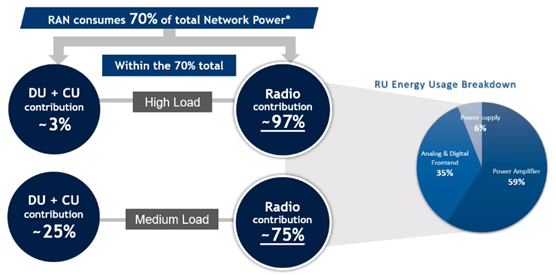
Based on observations at MWC 2024, vendors are focusing on passive sustainability efforts such as energy management in RAN. Key strategies include the following:
- Fronthaul control, cell admin state management, and energy-saving modes, all focusing on optimizing the power usage of radio units
- Enhanced power management states for servers and telemetry use, improving energy efficiency by monitoring and adjusting power usage in real time
- Deployment of RAN intelligent controllers, which use policy-based management and AI/ML techniques to enable intelligent energy management, including dynamically adapting network operations to current needs without compromising service quality
For example, Nokia showcased a new “extreme deep sleep” mode designed to reduce energy consumption. This feature uses Nokia’s AirScale radio architecture and its Reefshark system-on-chip chipsets and works by shutting down radio equipment during no-traffic periods, aiming for what Nokia calls “zero traffic, zero Watt.”
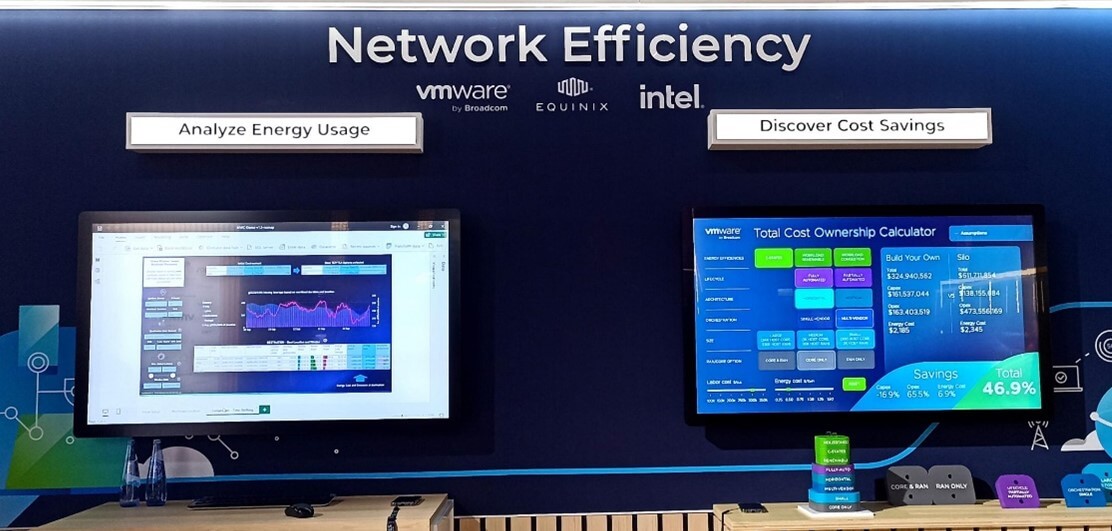
Additionally, VMware, a US-based cloud computing and virtualization technology company, presented its Network Efficiency framework, which was developed with Intel and Equinix, a US-based digital infrastructure company. The framework consists of two parts: a tool for analyzing energy usage and a tool to help discover cost savings. The former includes “green window”-based workload placement that simulates the impact of running some workloads during peak hours with lower energy costs.
“One of the main drivers for integration cost efficient energy saving features is ongoing global recession. Another driver is state policy with focus on ESG strict regulations and commitments of the companies to reach net zero in the next 10–15 years.”
– Solution Architect at VMware
What these telco IoT trends mean for the future of connectivity
From AI integration across the network-to-device spectrum to enhanced security and sustainability, the telecom trends observed at MWC Barcelona 2024—presented above and in the 123-page MWC Barcelona 2024 Event Report—are going to have a significant impact on IoT connectivity and the telecom industry as a whole. As more and more mobile and IoT devices come online, being able to provision them and ensure data security will be important for the continued growth of the IoT market. However, most of the projects supporting these trends were either announced or demonstrated at MWC 2024 or are currently being piloted—it may take 2 or 3 years before we see mass commercialization or impact of these projects. That said, these trends suggest a future of interconnected, intelligent, and sustainable telecom ecosystems catering to evolving consumer demands and technological advancements.
More information and further reading
Are you interested in learning more about latest telco trends?

MWC Barcelona 2024 Event Report—Analyst Takeaways
123-page report presenting a comprehensive summary of the key highlights and trends assembled by the IoT Analytics analyst team at Mobile World Congress (MWC) 2024. More than 130 companies are discussed.
Related articles
You may also be interested in the following articles:
- LPWAN market 2024: Licensed technologies boost their share among global 1.3 billion connections as LoRa leads outside China
- The vital role of industrial IoT gateways in bridging IT and OT
- The leading generative AI companies
- Smart electricity meter market 2024: Global adoption landscape
- Cellular IoT module & chipset market 2023: 18% decline due to destocking and softening demand in key segments
- State of IoT Spring 2024: 10 emerging IoT trends driving market growth
- What CEOs talked about in Q1 2024: AI, sustainability, and upcoming elections
Related publications
You may also be interested in the following reports:
- IoT Chipset & IoT Module Trends Report 2023
- IoT Gateway Market Report 2023–2027
- State of IoT Spring 2024
Related dashboard and trackers
You may also be interested in the following dashboards and trackers:
- Global LPWAN Market Tracker and Forecast 2015-2027 (Q1/2024 Update)
- Global Cellular IoT Connectivity Tracker & Forecast
- Global Smart Meter Market Tracker
- Global Cellular IoT Module and Chipset Market Tracker & Forecast
- Global Cellular IoT eSIM Module & iSIM Chipset Tracker
- Global IoT Enterprise Spending Dashboard
Subscribe to our newsletter and follow us on LinkedIn and Twitter to stay up-to-date on the latest trends shaping the IoT markets. For complete enterprise IoT coverage with access to all of IoT Analytics’ paid content & reports including dedicated analyst time check out Enterprise subscription.

